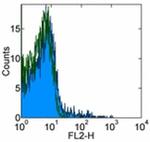Search Thermo Fisher Scientific
Invitrogen
CD195 (CCR5) Monoclonal Antibody (eBioT21/8 (T21/8)), eBioscience™
FIGURE: 1 / 1
CD195 (CCR5) Antibody (14-1957-82) in Flow

Product Details
14-1957-82
Species Reactivity
Published species
Host/Isotype
Class
Type
Clone
Conjugate
Form
Concentration
Purification
Storage buffer
Contains
Storage conditions
Shipping conditions
RRID
Product Specific Information
Description: The eBioT21/8 monoclonal antibody reacts with the amino terminus of human CCR5 (CD195), an approximately 45 kDa member of the G protein-coupled receptor (GPCR) superfamily that binds chemokines including MIP-1alpha, MIP-1beta and RANTES. Human CCR5 is expressed on resting T cells with a memory/effector phenotype, monocytes, macrophages and immature dendritic cells. CCR5 functions as a receptor to direct the chemotaxis of lymphocytes, and is the primary co-receptor for macrophage-tropic Human Immunodeficiency Virus Type 1 (HIV-1), which binds CCR5 through gp120. Binding of the eBioT21/8 monoclonal antibody displays donor variability and may be affected by sub-optimal staining conditions.
Applications Reported: This eBioT21/8 (T21/8) antibody has been reported for use in flow cytometric analysis, immunoprecipitation, immunoblotting (WB) and immunocytochemical staining. The eBioT21/8 monoclonal antibody has also been used as the capture antibody for the ELISA detection of human CCR5 in cell lysates.
Applications Tested: This eBioT21/8 (T21/8) antibody has been tested by flow cytometric analysis of normal human peripheral blood cells. For optimal performance, it is recommended that staining with NP-6G4 be done at 37°C for 1 hour in Flow Cytometry Staining Buffer (Product # 00-4222-57). This can be used at less than or equal to 0.5 µg per test. A test is defined as the amount (µg) of antibody that will stain a cell sample in a final volume of 100 µL. Cell number should be determined empirically but can range from 10^5 to 10^8 cells/test. It is recommended that the antibody be carefully titrated for optimal performance in the assay of interest. Binding of the eBioT21/8 monoclonal antibody displays donor variability and may be affected by sup-optimal staining conditions. Therefore, staining conditions should be closely monitored to ensure consistent staining.
Purity: Greater than 90%, as determined by SDS-PAGE.
Aggregation: Less than 10%, as determined by HPLC.
Filtration: 0.2 µm post-manufacturing filtered.
Target Information
Human immunodeficiency virus (HIV) and related virus require coreceptors, in addition to CD4, to infect target cells. Some G protein-coupled receptors including CCR5, CXCR4, CCR3, CCR2b and CCR8 in the chemokine receptor family, and four new human molecules GPR15, STRL33, GPR1 and V28 were recently identified as HIV coreceptors. Among them, CCR5 (CC-CKR-5) is a principal coreceptor for macrophage- and dual-tropic HIV-1 strains fusion and entry of human white blood cells. CCR5 is required for the infection by HIV-1, HIV-2, and SIV. The beta-chemokines RANTES, MIP-alpha and MIP-beta are the ligands for CCR5 and prevent infection by M-tropic HIV-1. CCR5 associates with the surface CD4-gp120 of HIV complex and leads to membrane fusion and virus entry of target cells. The amino-terminal domain and the extracellular loops of CCR5 serve as HIV biding sites. CCR5 messenger RNA is expressed in lymphoid organs and monocytes.
For Research Use Only. Not for use in diagnostic procedures. Not for resale without express authorization.
Bioinformatics
Protein Aliases: C-C chemokine receptor type 5; C-C CKR-5; C-C motif chemokine receptor 5 A159A; CD195; CD195 antigen; chemokine (C-C motif) receptor 5; chemokine receptor CCR5; CHEMR13; HIV-1 fusion coreceptor
Gene Aliases: CC-CKR-5; CCCKR5; CCR-5; CCR5; CD195; CKR-5; CKR5; CMKBR5; IDDM22
UniProt ID: (Human) P51681
Entrez Gene ID: (Human) 1234

Performance Guarantee
If an Invitrogen™ antibody doesn't perform as described on our website or datasheet,we'll replace the product at no cost to you, or provide you with a credit for a future purchase.*
Learn more
We're here to help
Get expert recommendations for common problems or connect directly with an on staff expert for technical assistance related to applications, equipment and general product use.
Contact tech support
